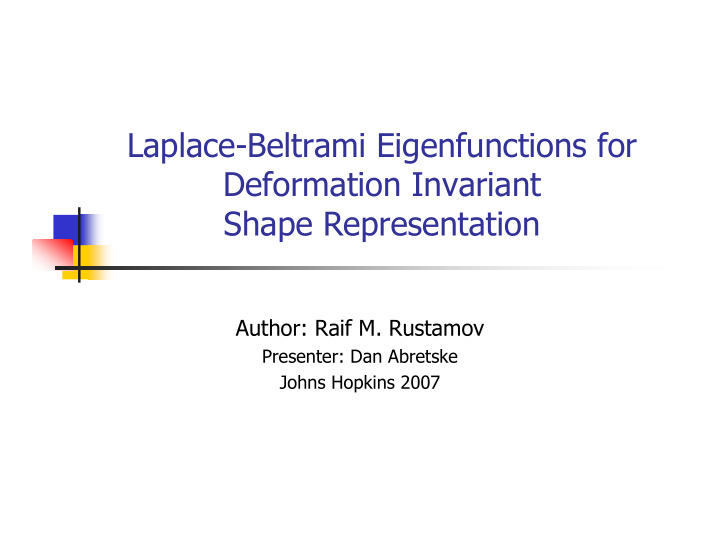



Laplace-Beltrami Eigenfunctions for Deformation Invariant Shape Representation Author: Raif M. Rustamov Presenter: Dan Abretske Johns Hopkins 2007
Outline Motivation and Background Laplace-Beltrami Operator Global Point Signature Discretization Results
Motivation Two Goals: Goal 1: A Shape Representation Invariant under ‘Natural’ Deformations. Goal 2: A Shape Representation Useful in Shape Matching, Retrieval, Correspondence and Segmentation
Previous Work Spectral Embedding of Pairwise Geodesic Distances into Euclidean Space [intrinsic measures] Generally, invariant to articulation since geodesic distance is usually changed little by such motions Hence, it is an isometry invariant representation Sensitive to ‘short circuits’ or topological changes of the mesh Add Euclidean Distances to the Spectral Embedding [extrinsic and intrinsic measures] Better at handling ‘short circuits’ and topological changes, but no longer isometry invariant
Laplace-Beltrami Operator Laplace-Beltrami is just a Laplacian Operator defined with respect to the metric on a Reimannian Manifold I.e. it is defined on the surface rather than in the embedding space. We can discuss the eigenvalues and eigenfunction of the operator � � = ��
Laplace-Beltrami Operator A mess of equations about the operator telling us that the eigenvalues ascend from zero and that the eigenfunctions from an orthogonal basis for functions on the surface � 0 = 0 < � 1 < � 2 < K < � i < K � � f , g � = fg S � � i , � i � = 1, � � i , � j � = 0 � � f = c i � i , c i = � f , � i � i = 0
Global Point Signature(GPS) Can points on the surface be characterize intrinsically? Rustamov tells us, “Yes, they can.” So Define the Global Point Signature(GPS) as the infinite dimensional vector � � 1 � 1 ( p ), 1 � 2 ( p ), 1 � 3 ( p ), L GPS ( p ) = � � � � � 1 � 2 � 3 � � Note: The zeroth eigenfuncton provides no useful information since it is a constant valued function and that this is an embedding of the surface into an infinite dimensional space.
Properties of GPS 1) The GPS embedding of a surface without self- intersections has no self-intersections Proof: Suppose two distinct points have equal GPS values. Then their eigenfunctions have equal value at these points. Thus given any function f, the eigenfunction expansion of f will converge pointwise(under mild assumptions) and so f(p)=f(q). However, since these are unique points we can find an f such that f(p) does not equal f(q). Contradiction.
Properties of GPS 2) GPS embeddings are isometry invariant Proof: GPS is defined in terms of the Laplace-Beltrami operator which is defined in terms of the surface metric tensor which is isometry invariant.
Properties of GPS 3) Given the GPS embedding and the eigenvalues, we can recover the surface up to an isometry. Proof: The eigenfunctions form a complete basis of the function space and thus knowledge of the Laplace-Beltrami operator. The Laplace-Beltrami operator can be used to recover the metric. However since the metric is isometry invariant we can only recover the surface up to an isometry.
Properties of GPS 4) The GPS embedding is absolute, it is not subject to rotations or translation of the ambient infinite- dimensional space Proof: Rotations and Translations of the shape are isometries with respect to the surface metric.
Properties of GPS 5) The inner product, thus the Euclidean distance, in the GPS domain has meaningful interpretation � u = g One can solve the Laplace equation via Green’s Function and Convolution as � u ( x ) = G ( x , � x ) g ( � x ) S Thus Green’s Function, G(x,x’), gives an indication of how much influence g(x’) has on the solution at u(x). Fact: G(x,x’) can be written as <GPS(x),GPS(x’)>
Discretization For GPS to work it requires that we use a discrete approximation of the Laplacian and not a graphical approximation. i.e. the area weighted cotangent formulation of the Laplacian is the desired one. Problem: This discretization of the Laplacian is non- symmetric. So there is no longer any guarantee that the eigenvalues or eigenvectors of Laplacian will be real or that numerical methods will give real results even if they are.
Generalized Eigenvalue Problem Formulation: Av= µ Bv If A is symmetric and B is symetric positive-definite then the generalized eigenvectors v are B-orthogonal. Write L=S -1 M where S is diagonal and encodes the areas of the cotangent meshes and M encodes the cotangent weights Then we can solve the generalized eigenvalue problem: Mv= µ Sv M is symmetric and S is symmetric positive definite. Numerically this formulation seems to yield real eigenvalues as well.
Geometric Interpretation Fun result: The S-orthogonality of the generalized eigenvalue problem for the cotangent Laplacian is in fact the correct discretization of the surface integral That means the continuous inner product in fact discretizes to the S-inner product.
Shape Classification Project GPS onto the first d dimensions. Form a histogram of the pairwise distances between points in the projected space. [this is the basis of d2 distributions] ‘Enhance’ d2 by adding m equally spaced spherical shells and then forming m(m+1)/2 histograms by taking pairwise distances of points in selected ‘annuli’
Results: Shape Segmentation
Results: Shape Clustering
Recommend
More recommend